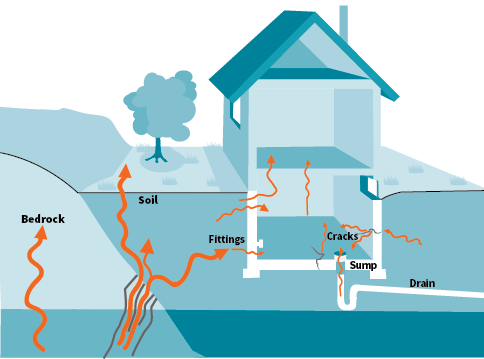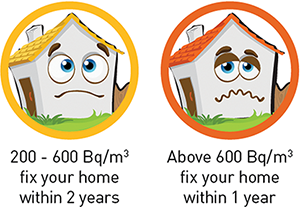Radon: Test Your Home
What is radon?
Radon is a colourless, odourless and tasteless radioactive gas. It is produced naturally in the environment when uranium in rock and soil breaks down. Radon gas released directly from the ground into the outdoor environment is diluted to low levels. Radon can enter a building anywhere there is an opening in contact with the soil. Radon gas can also enter a building through cracks and openings where the foundation is in contact with the soil. It can build up to high concentrations in poorly ventilated areas, like basements.
Radon gas is found at low levels in almost every home. It is estimated that 4.6 % of Ontarians live in homes with radon levels above the current Canadian radon guideline of 200 Bq/m3 (Source: Public Health Ontario)

Why is radon a health concern?
Radon gas can become a health risk if it is able to buildup to high levels. These risks do not come from immediate exposure, but from long-term exposure to high levels of radon.
Radon is the second leading cause of lung cancer, after smoking, and is responsible for almost 850 lung cancer deaths in Ontario each year (Source: Public Health Ontario). Exposure to radon does not produce any immediate symptoms, like coughing or headaches, so you may not realize you have been exposed. This is why it’s important to test your home for radon levels.
If you are a smoker and exposed to radon, your risk of lung cancer increases. Reducing your exposure to radon and other risk factors (e.g. smoking) will greatly reduce your risk. Learn more about taking the first step towards quitting smoking.
The York Region “Radon - Test Your Home” study
To gain a better understanding of radon levels in York Region, public health initiated a study in 2017 to assess radon levels in residential homes. Public health offered homeowners the opportunity to test radon levels in their homes for free, as part of the Radon - Test Your Home Study.
The purpose of the study was to:
- Measure radon levels in residential homes across York Region
- Better understand York Region residents knowledge and awareness of radon and the associated health risks
- Increase awareness and inform residents about the risk of radon
Around 500 homeowners tested their homes for at least 91 days from fall 2017 to summer 2018. The majority of York Region homes had low levels of radon that were well below the Health Canada guideline. Find out more about the study results.
Testing for radon
While the study found low levels, it is still recommended to test your home to know what your risk may be. The only way to know if a home has an elevated level of radon is to test for it. To get an accurate measure of radon exposure, Health Canada recommends testing your home for a minimum of three months during the fall and winter months, when windows and doors are generally closed.
Radon test kits can be purchased for approximately $45 to $70 from a home improvement retailer, online or by contacting a certified radon measurement professional. Additional costs may be required for laboratory analysis.
How to get a test kit
Visit takeactionradon.ca/test for more information on where you can purchase a test kit or hire a professional.
You may be eligible for a free test kit! You can order a free radon test kit during the month of November by completing the Canadian Cancer Society’s free radon test kit form or by calling their Cancer Information Line at 1-888-939-3333 (quantities may be limited.)
How to set up a test kit
Visit Health Canada’s Guide for Radon Measurements in Residential Dwellings (Homes) for more information on how to test your home.
What happens if my radon results are high?
The Canadian radon guideline is 200 Bq/m3. Health Canada recommends homes with radon levels between 200 and 600 Bq/m3; be fixed within two years; homes with radon levels above 600 Bq/m3 should be fixed within one year.

If your test results show elevated radon levels, consult with a certified radon mitigation specialist on what you can do to reduce levels in your home.
- Contact the Canadian National Radon Proficiency Program (C-NRPP) at 1-855-722-6777 (email: info@c-nrpp.ca), or the Canadian Association of Radon Scientists and Technologists (CARST) at info@carst.ca for a certified mitigation specialist.
- Under Ontario’s new 2024 Building Code, radon mitigation requirements have been strengthened to include a rough-in for future radon extraction equipment if radon is discovered to be a problem in a house after it is built and occupied. The 2024 Building Code comes into effect January 1, 2025.
- In Ontario, the Tarion Warranty covers new homes for the first seven years after construction. If the home tests above the Health Canada radon guideline, the warranty program covers the cost of the radon mitigation system if installed by a C-NRPP Professional.
- Radon Grants: The Canadian Lung Association recently launched the Lungs Matter Mitigation Grant Program to help people across Canada afford radon mitigation services. Grants are available to individuals who have been diagnosed with lung cancer and individuals in a low to moderate income household. Individuals may be eligible for up to $1,500 towards radon mitigation.
For more information on fixing your home to reduce radon, review Health Canada’s Radon - Reduction Guide for Canadians
Related Resources
- Health Canada’s Radon website
- Take Action on Radon for more information on Radon Action Month
- Public Health Ontario’s Radon Risks and Realities Infographic
- Radon Resources for Health Professionals
- Radon resources for Schools
- Evict Radon National Study
- Radon Risk: Healthy Canadians Podcast Episode 1


